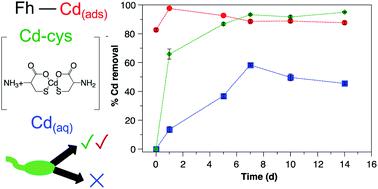当前位置:
X-MOL 学术
›
Environ. Sci.: Processes Impacts
›
论文详情
Our official English website, www.x-mol.net, welcomes your feedback! (Note: you will need to create a separate account there.)
Complexation by cysteine and iron mineral adsorption limit cadmium mobility during metabolic activity of Geobacter sulfurreducens.
Environmental Science: Processes & Impacts ( IF 5.5 ) Pub Date : 2020-08-10 , DOI: 10.1039/d0em00244e E J Tomaszewski 1 , L Olson 2 , M Obst 3 , J M Byrne 4 , A Kappler 2 , E M Muehe 5
Environmental Science: Processes & Impacts ( IF 5.5 ) Pub Date : 2020-08-10 , DOI: 10.1039/d0em00244e E J Tomaszewski 1 , L Olson 2 , M Obst 3 , J M Byrne 4 , A Kappler 2 , E M Muehe 5
Affiliation

|
Cadmium (Cd) adversely affects human health by entering the food chain via anthropogenic activity. In order to mitigate risk, a better understanding of the biogeochemical mechanisms limiting Cd mobility in the environment is needed. While Cd is not redox-active, Cd speciation varies (i.e., aqueous, complexed, adsorbed), and influences mobility. Here, the cycling of Cd in relation to initial speciation during the growth of Geobacter sulfurreducens was studied. Either fumarate or ferrihydrite (Fh) was provided as an electron acceptor and Cd was present as: (1) an aqueous cation, (2) an aqueous complex with cysteine, which is often present in metal stressed soil environments, or (3) adsorbed to Fh. During microbial Fe(III) reduction, the removal of Cd was substantial (∼80% removal), despite extensive Fe(II) production (ratio Fe(II)total : Fetotal = 0.8). When fumarate was the electron acceptor, there was higher removal from solution when Cd was complexed with cysteine (97–100% removal) compared to aqueous Cd (34–50%) removal. Confocal laser scanning microscopy (CLSM) demonstrated the formation of exopolymeric substances (EPS) in all conditions and that Cd was correlated with EPS in the absence of Fe minerals (r = 0.51–0.56). Most notable is that aqueous Cd was more strongly correlated with Geobacter cells (r = 0.72) compared to Cd–cysteine complexes (r = 0.51). This work demonstrates that Cd interactions with cell surfaces and EPS, and Cd solubility during metabolic activity are dependent upon initial speciation. These processes may be especially important in soil environments where sulfur is limited and Fe and organic carbon are abundant.
中文翻译:

半胱氨酸和铁矿物质吸附的络合作用限制了土壤还原性硫杆菌的代谢过程中的镉迁移率。
镉通过人为活动进入食物链,对人类健康产生不利影响。为了减轻风险,需要对限制地球上Cd迁移的生物地球化学机制有更好的了解。尽管Cd不具有氧化还原活性,但Cd的形态会发生变化(即,含水,络合,吸附),并影响迁移率。在此,研究了还原性土壤杆菌生长过程中Cd的循环与初始形态的关系。提供富马酸盐或亚铁酸盐(Fh)作为电子受体,Cd的存在形式为:(1)阳离子水溶液;(2)与半胱氨酸形成的水溶液络合物,通常存在于金属胁迫的土壤环境中;或(3)吸附到Fh。过程中的微生物的Fe(III)还原,尽管产生了大量的Fe(II),但Cd的去除却是相当可观的(〜80%的去除)(Fe(II)总量比 :Fe总量= 0.8)。当富马酸酯是电子受体时,与水溶液中Cd的去除率(34-50%)相比,当Cd与半胱氨酸复合时,从溶液中去除率更高。共聚焦激光扫描显微镜(CLSM)证明在所有条件下均会形成外聚物质(EPS),并且在不存在铁矿物质的情况下Cd与EPS相关(r = 0.51-0.56)。最显着的是,镉水溶液更强烈相关地杆菌细胞(ř相比镉半胱氨酸络合物= 0.72)(ř= 0.51)。这项工作表明镉与细胞表面和EPS的相互作用以及代谢活动过程中镉的溶解度取决于初始形态。在硫含量有限,铁和有机碳含量丰富的土壤环境中,这些过程尤其重要。
更新日期:2020-09-23
中文翻译:

半胱氨酸和铁矿物质吸附的络合作用限制了土壤还原性硫杆菌的代谢过程中的镉迁移率。
镉通过人为活动进入食物链,对人类健康产生不利影响。为了减轻风险,需要对限制地球上Cd迁移的生物地球化学机制有更好的了解。尽管Cd不具有氧化还原活性,但Cd的形态会发生变化(即,含水,络合,吸附),并影响迁移率。在此,研究了还原性土壤杆菌生长过程中Cd的循环与初始形态的关系。提供富马酸盐或亚铁酸盐(Fh)作为电子受体,Cd的存在形式为:(1)阳离子水溶液;(2)与半胱氨酸形成的水溶液络合物,通常存在于金属胁迫的土壤环境中;或(3)吸附到Fh。过程中的微生物的Fe(III)还原,尽管产生了大量的Fe(II),但Cd的去除却是相当可观的(〜80%的去除)(Fe(II)总量比 :Fe总量= 0.8)。当富马酸酯是电子受体时,与水溶液中Cd的去除率(34-50%)相比,当Cd与半胱氨酸复合时,从溶液中去除率更高。共聚焦激光扫描显微镜(CLSM)证明在所有条件下均会形成外聚物质(EPS),并且在不存在铁矿物质的情况下Cd与EPS相关(r = 0.51-0.56)。最显着的是,镉水溶液更强烈相关地杆菌细胞(ř相比镉半胱氨酸络合物= 0.72)(ř= 0.51)。这项工作表明镉与细胞表面和EPS的相互作用以及代谢活动过程中镉的溶解度取决于初始形态。在硫含量有限,铁和有机碳含量丰富的土壤环境中,这些过程尤其重要。


























 京公网安备 11010802027423号
京公网安备 11010802027423号